Click on images to enlarge
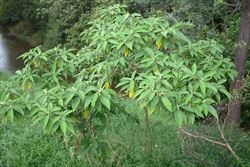
habit (Photo: Sheldon Navie)
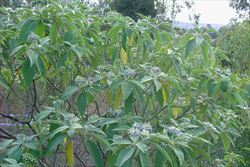
habit (Photo: Sheldon Navie)
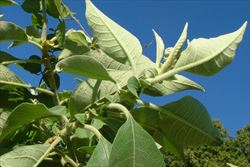
leaves (Photo: Sheldon Navie)
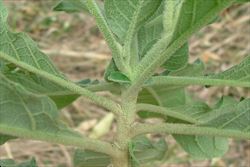
younger stem and leaf stalks (Photo: Sheldon Navie)
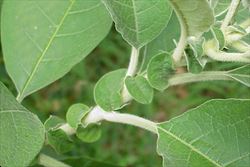
ear-shaped leaves at bases of leaf stalks (Photo: Sheldon Navie)
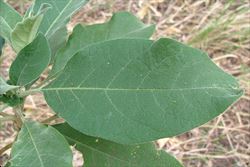
leaf (Photo: Sheldon Navie)
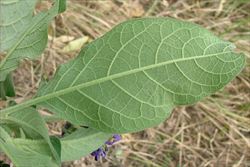
leaf underside (Photo: Sheldon Navie)
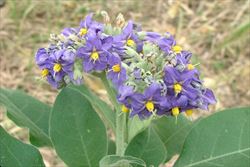
flower cluster (Photo: Sheldon Navie)

close-up of flowers (Photo: Sheldon Navie)
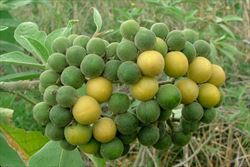
immature and mature fruit (Photo: Sheldon Navie)
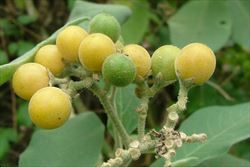
close-up of fruit (Photo: Sheldon Navie)
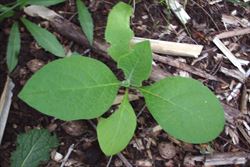
seedling (Photo: Sheldon Navie)
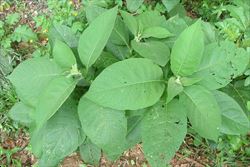
young plants (Photo: Sheldon Navie)
Scientific Name
Solanum mauritianum Scop.
Synonyms
Solanum auriculatum Ait.
Family
Solanaceae
Common Names
bug berry, bug tree, bugtree, bugweed, earleaf nightshade, flannel leaf, kerosene plant, tobacco bush, tobacco weed, tree tobacco, wild tobacco, wild tobacco bush, wild tobacco plant, wild tobacco tree, woolly nightshade
Origin
Native to South America (i.e. Brazil, Uruguay and northern Argentina).
Naturalised Distribution
This species is widely naturalised in eastern and south-eastern Australia. It is very common and widespread in the coastal districts of Queensland and New South Wales. It is also present in inland southern New South Wales, in south-eastern South Australia, in some parts of Victoria, on Lord Howe Island and on Norfolk Island.
Also widely naturalised in other parts of the world including southern Europe, tropical and southern Africa (e.g. South Africa, Zimbabwe and Madagascar), southern USA (i.e. California and Florida), the Mascarenes (i.e. La Réunion and Mauritius), New Zealand and on several Pacific Islands (e.g. the Cook Islands, Fiji, New Caledonia, Tonga and Hawaii).
Habitat
A common weed of untended suburban areas, roadsides, disturbed sites, waste areas, waterways, open woodlands, closed forests and remnant rainforest areas.
Habit
A long-lived (i.e. perennial) shrub or small branching tree usually growing 1.5-4 m tall, but capable of reaching up to 10 m in height.
Distinguishing Features
- a large shrub or small tree usually growing 1.5-4 m tall.
- its large leaves have entire margins and densely hairy undersides.
- one or two ear-shaped leafy structures are usually present at the base of the leaf stalks.
- its mauve or purple star-shaped flowers are produced in dense branched clusters.
- its fruit are yellow globular berries (10-15 mm across).
Stems and Leaves
The stems and leaves are felty, due to a covering of soft star-shaped (i.e. stellate) hairs. Younger stems are green or greyish-green in colour, while older stems are greyish-brown and somewhat woody in nature.
The alternately arranged leaves are borne on stalks (i.e. petioles) 1-9 cm long and have entire or slightly wavy (i.e. undulate) margins. The large leaf blades (7.5-40 cm long and 3-15 cm wide) are egg-shaped in outline (i.e ovate) or oval (i.e. elliptic) in shape and have pointed tips (i.e. acute apices). The upper leaf surfaces are green and sparsely hairy, while the lower surfaces are paler greyish-green and densely hairy (i.e. stellate pubescent). At the base of the larger leaves there are one or two small, stalkless (i.e. sessile), ear-shaped (i.e. auriculate) leaves (5-20 mm long).
Flowers and Fruit
The purple or violet coloured flowers (15-25 mm across) are star-shaped (i.e. stellate) and arranged in dense clusters containing 25-100 flowers. These clusters are produced at the tips of the branches (i.e. in terminal panicles or corymbs) on a main stalk (i.e. peduncle) 3-18 cm long. Individual flowers are borne on stalks (i.e. pedicels) 2-3 mm long and five green sepals (4-6 mm long) that are hairy (i.e. stellate pubescent) and partially fused at the base (i.e. into a calyx tube). Their petals (7-13 mm long) are also joined together at the base and have pointed lobes (i.e. acute corolla lobes). Each of these lobes usually has a white stripe running part way down its centre. The flowers also have five yellow stamens with anthers (2-3.5 mm long) that are pressed together (i.e. cohering) and surround the style. The style is 5-7 mm long and topped with a green stigma. Flowering occurs mainly from autumn through to spring (i.e. from March to November).
The fruit are rounded (i.e. globular), soft, berries (10-15 mm across) and turn from green to dull yellow as they mature. Immature fruit are quite hairy, but the hairs are mostly lost as the fruit begin to mature. These fruit contain many small seeds (1.5-2 mm long) that are light brown or yellowish in colour.
Reproduction and Dispersal
This species reproduces by seed.
The seeds are mainly dispersed by birds and other animals that eat the fruit. They may also be spread in dumped garden waste.
Environmental Impact
Wild tobacco tree (Solanum mauritianum) is regarded a san environmental weed in Queensland, New South Wales, Victoria and South Australia. It was also recently listed as a priority environmental weed in at least one Natural Resource Management region.
Legislation
Not declared or considered noxious by any state government authorities.
Management
For information on the management of this species see the following resources:
- the Biosecurity Queensland Fact Sheet on this species, which is available online at http://www.dpi.qld.gov.au.
Similar Species
Wild tobacco tree (Solanum mauritianum) is very similar to potato tree (Solanum erianthum) and relatively similar to devil's fig (Solanum torvum). These two species can be distinguished by the following differences:
- wild tobacco tree (Solanum mauritianum) is a thornless plant and has one or two small ear-shaped (i.e. auriculate) leaves at the base of each leaf stalk (i.e. petiole). Its star-shaped flowers have purple or violet coloured petals (sometimes with a small white stripe) and its leaves have entire margins.
- potato tree (Solanum erianthum) is a thornless plant and does not have any ear-shaped (i.e. auriculate) leaves at the base of each leaf stalk (i.e. petiole). Its star-shaped flowers have white petals and its leaves have entire margins.
- devil's fig (Solanum torvum) has thorny stems and does not have any ear-shaped (i.e. auriculate) leaves at the base of each leaf stalk (i.e. petiole). Its star-shaped flowers have white petals and its leaves usually have slightly lobed margins.
Note: For a more in-depth key to distinguish between all of the solanums (Solanum spp.) present in eastern Australia, see the online key to the Solanum Species of Eastern Australia at http://delta-intkey.com/solanum/index.htm.

